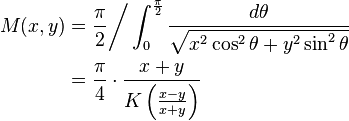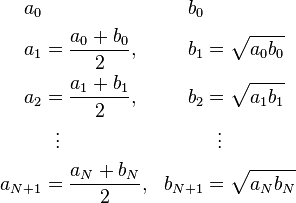Arithmetic–geometric mean
In mathematics, the arithmetic–geometric mean (AGM) of two positive real numbers x and y is defined as follows:
First compute the arithmetic mean of x and y and call it a1, and the geometric mean of x and y and call it g1 (this is the square root of the product xy):
Then iterate this operation with a1 taking the place of x and g1 taking the place of y. In this way, two sequences (an) and (gn) are defined:
These two sequences converge to the same number, which is the arithmetic–geometric mean of x and y; it is denoted by M(x, y), or sometimes by agm(x, y).
This can be used for algorithmic purposes as in the AGM method, which makes it possible to construct fast algorithms for calculation of exponential and trigonometric functions, and some mathematical constants and in particular, to quickly  .
.
Example
To find the arithmetic–geometric mean of a0 = 24 and g0 = 6, first calculate their arithmetic mean and geometric mean, thus:
and then iterate as follows:
The first five iterations give the following values:
n an gn 0 24 6 1 15 12 2 13.5 13.416407864998738178455042… 3 13.458203932499369089227521… 13.458139030990984877207090… 4 13.458171481745176983217305… 13.458171481706053858316334… 5 13.458171481725615420766820… 13.458171481725615420766806…
As can be seen, the number of digits in agreement (underlined) approximately doubles with each iteration. The arithmetic–geometric mean of 24 and 6 is the common limit of these two sequences, which is approximately 13.4581714817256154207668131569743992430538388544.[1]
History
The first algorithm based on this sequence pair appeared in the works of Lagrange. Its properties were further analyzed by Gauss.[2]
Properties
The geometric mean of two positive numbers is never bigger than the arithmetic mean (see inequality of arithmetic and geometric means); as a consequence, (gn) is an increasing sequence, (an) is a decreasing sequence, and gn ≤ M(x, y) ≤ an. These are strict inequalities if x ≠ y.
M(x, y) is thus a number between the geometric and arithmetic mean of x and y; it is also between x and y.
If r ≥ 0, then M(rx,ry) = r M(x,y).
There is an integral-form expression for M(x,y):
where K(k) is the complete elliptic integral of the first kind:
Indeed, since the arithmetic–geometric process converges so quickly, it provides an efficient way to compute elliptic integrals via this formula. In engineering, it is used for instance in elliptic filter design.[3]
Related concepts
The reciprocal of the arithmetic–geometric mean of 1 and the square root of 2 is called Gauss's constant, after Carl Friedrich Gauss.
The geometric–harmonic mean can be calculated by an analogous method, using sequences of geometric and harmonic means. The arithmetic–harmonic mean can be similarly defined, but takes the same value as the geometric mean.
The arithmetic–geometric mean can be used to compute logarithms and complete elliptic integrals of the first kind. A modified arithmetic–geometric mean (MAGM) can be used to efficiently compute complete elliptic integrals of the second kind.[4] Both AGM and MAGM turn out being special cases of the generalized arithmetic–geometric mean (GAGM).[5]
Proof of existence
From inequality of arithmetic and geometric means we can conclude that:
and thus
that is, the sequence gn is nondecreasing.
Furthermore, it is easy to see that it is also bounded above by the larger of x and y (which follows from the fact that both arithmetic and geometric means of two numbers both lie between them). Thus by the monotone convergence theorem the sequence is convergent, so there exists a g such that:
However, we can also see that:
and so:
Proof of the integral-form expression
This proof is given by Gauss.[2] Let
Changing the variable of integration to  , where
, where
gives
Thus, we have
The last equality comes from observing that  .
.
Finally, we obtain the desired result
AGM method
Gauss noticed[6][7] that the sequences
as
have the same limit:
the arithmetic–geometric mean.
It is possible to use this fact to construct fast algorithms for calculating elementary transcendental functions and some classical constants, in particular, the constant π.
Applications
The number π
For example, according to the Gauss–Salamin formula:[8]
where
which can be computed without loss of precision using
Complete elliptic integral K(α)
At the same time, if we take
then
where K(α) is a complete elliptic integral
Other applications
Using this property of the AGM and also the ascending transformations of Landen,[9] Richard Brent[10] suggested the first AGM algorithms for fast evaluation of elementary transcendental functions (ex, cos x, sin x). Subsequently, many authors went on to study the use of the AGM algorithms, see, for example, the book Pi and the AGM by Jonathan and Peter Borwein.[11]
See also
External links
References
- Adlaj, Semjon (September 2012). "An eloquent formula for the perimeter of an ellipse" (PDF). Notices of the AMS 59 (8): 1094–1099. doi:10.1090/noti879.
- Jonathan Borwein, Peter Borwein, Pi and the AGM. A study in analytic number theory and computational complexity. Reprint of the 1987 original. Canadian Mathematical Society Series of Monographs and Advanced Texts, 4. A Wiley-Interscience Publication. John Wiley & Sons, Inc., New York, 1998. xvi+414 pp. ISBN 0-471-31515-X MR 1641658
- Zoltán Daróczy, Zsolt Páles, Gauss-composition of means and the solution of the Matkowski–Suto problem. Publ. Math. Debrecen 61/1-2 (2002), 157–218.
- M. Hazewinkel (2001), "Arithmetic–geometric mean process", in Hazewinkel, Michiel, Encyclopedia of Mathematics, Springer, ISBN 978-1-55608-010-4
- Weisstein, Eric W., "Arithmetic–Geometric mean", MathWorld.
- ↑ agm(24, 6) at WolframAlpha
- 1 2 David A. Cox (2004). "The Arithmetic-Geometric Mean of Gauss". In J.L. Berggren, Jonathan M. Borwein, Peter Borwein. Pi: A Source Book. Springer. p. 481. ISBN 978-0-387-20571-7. first published in L'Enseignement Mathématique, t. 30 (1984), p. 275-330
- ↑ Hercules G. Dimopoulos (2011). Analog Electronic Filters: Theory, Design and Synthesis. Springer. pp. 147–155. ISBN 978-94-007-2189-0.
- ↑ Adlaj, Semjon (September 2012), "An eloquent formula for the perimeter of an ellipse" (PDF), Notices of the AMS 59 (8): 1094–1099, doi:10.1090/noti879, retrieved 2013-12-14
- ↑ Adlaj, Semjon. "An arithmetic-geometric mean of a third kind!" (PDF). Retrieved 29 December 2015.
- ↑ B. C. Carlson (1971). "Algorithms involving arithmetic and geometric means". Amer. Math. Monthly 78: 496–505. doi:10.2307/2317754. MR 0283246.
- ↑ B. C. Carlson (1972). "An algorithm for computing logarithms and arctangents". Math.Comp. 26 (118): 543–549. doi:10.2307/2005182. MR 0307438.
- ↑ E. Salamin (1976). "Computation of
 using arithmetic-geometric mean". Math. Comp. 30 (135): 565–570. doi:10.2307/2005327. MR 0404124.
using arithmetic-geometric mean". Math. Comp. 30 (135): 565–570. doi:10.2307/2005327. MR 0404124. - ↑ J. Landen (1775). "An investigation of a general theorem for finding the length of any arc of any conic hyperbola, by means of two elliptic arcs, with some other new and useful theorems deduced therefrom". Philosophical Transactions of the Royal Society 65: 283–289. doi:10.1098/rstl.1775.0028.
- ↑ R.P. Brent (1976). "Fast Multiple-Precision Evaluation of Elementary Functions". J. Assoc. Comput. Mach. 23 (2): 242–251. doi:10.1145/321941.321944. MR 0395314.
- ↑ Borwein, J.M.; Borwein, P.B. (1987). Pi and the AGM. New York: Wiley. ISBN 0-471-83138-7. MR 0877728.

























